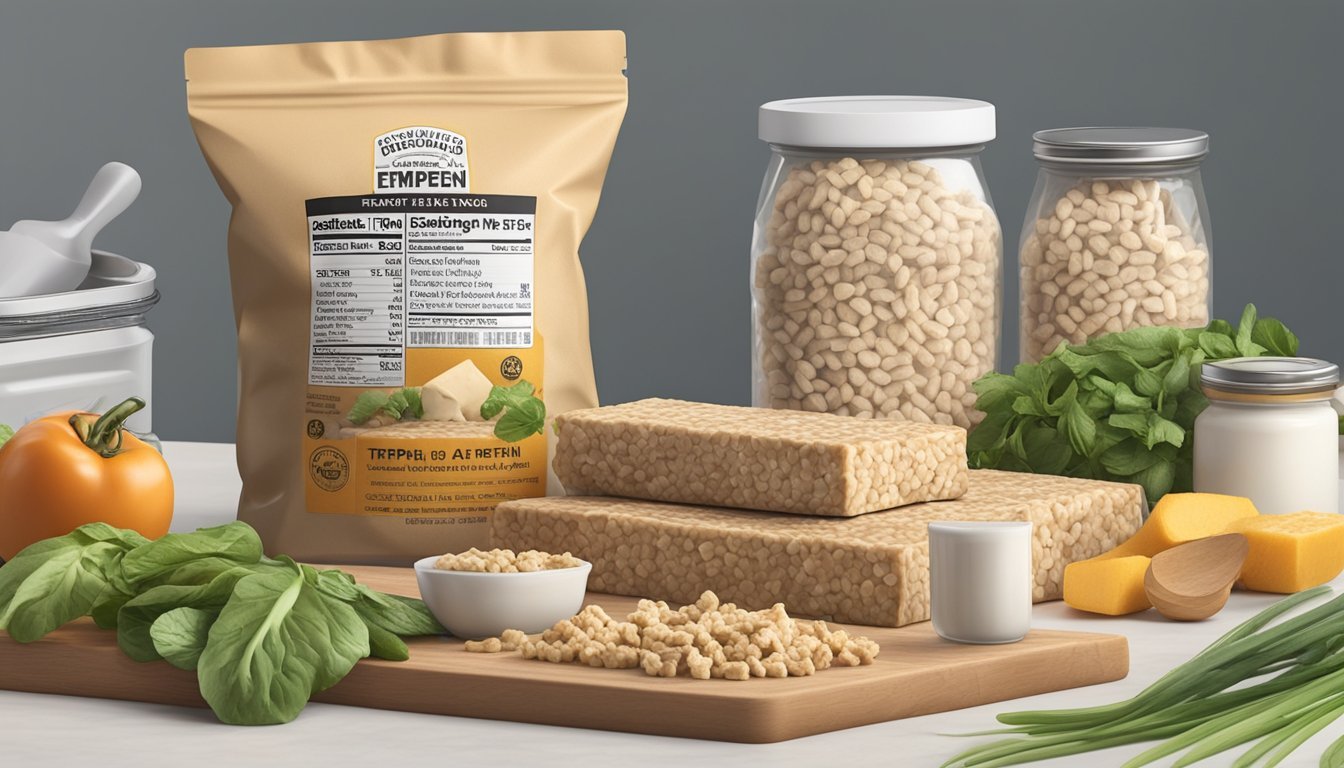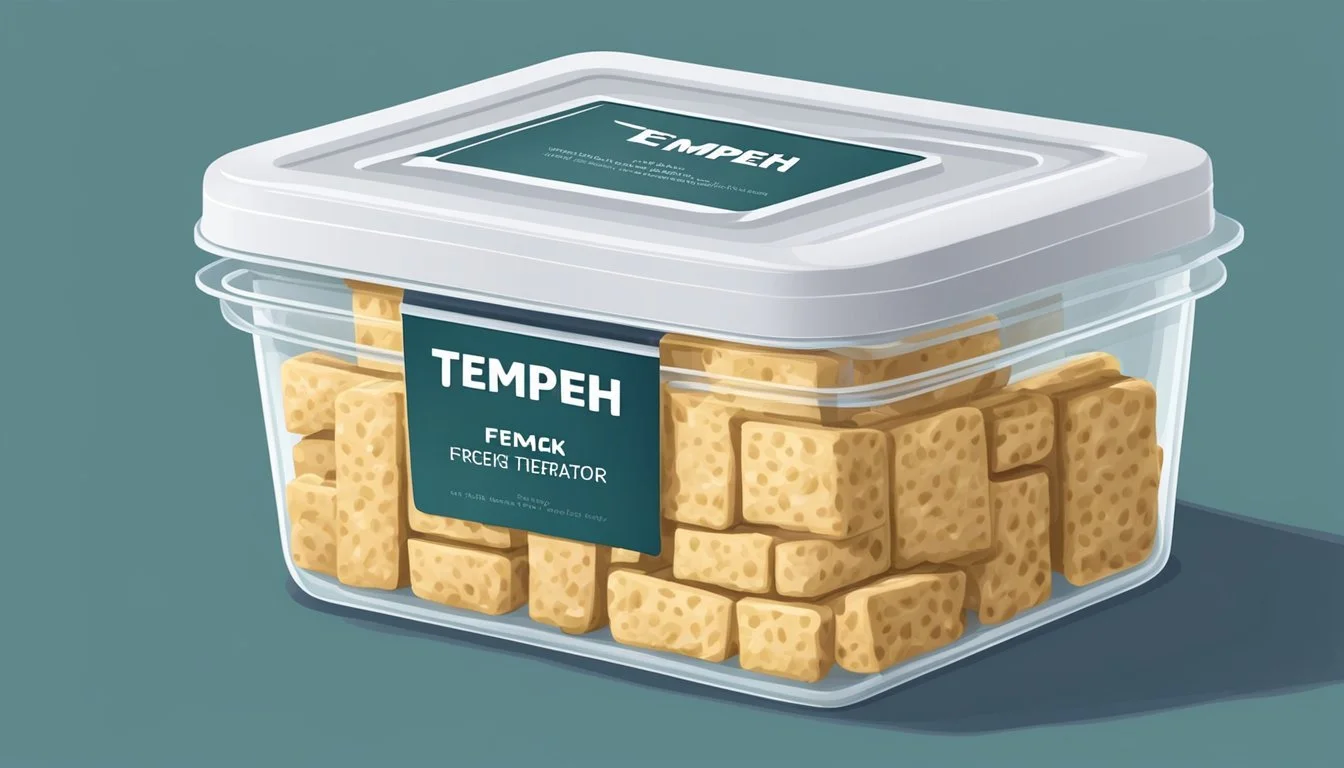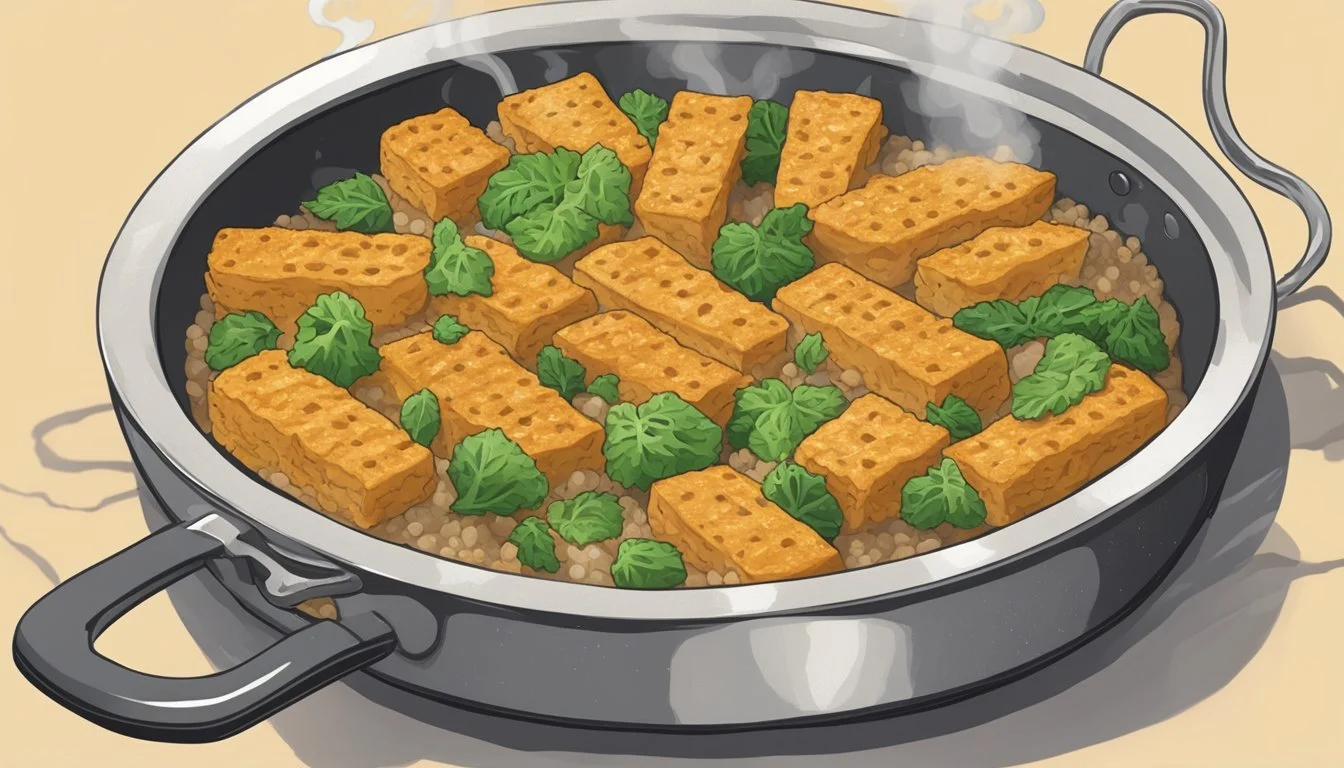Does Tempeh Go Bad?
Understanding Shelf Life and Storage Tips
Tempeh, a fermented soybean product, has a history rooted in ancient Indonesia and is beloved for its rich, nutty flavor. Given its nature as a fermented food, many wonder if tempeh can go bad. Yes, tempeh can go bad if not stored properly or if it has exceeded its expiration date.
Fresh tempeh should exhibit a white or cream color and a firm texture. A healthy block of tempeh will typically smell earthy or nutty, similar to edible mushrooms. A rotten smell, often resembling pure alcohol or strong ammonia, can signal that the tempeh has spoiled.
Despite the fermentation process, which aims to preserve tempeh and extend its shelf life, the product is still susceptible to contamination. Unwanted molds or bacteria, which do not share the distinctive characteristics of healthy fermenting fungus, can compromise the quality. Understanding these signs can help ensure the tempeh remains safe and enjoyable to eat.
Understanding Tempeh
Tempeh is a versatile, nutrient-rich food that has become increasingly popular for its health benefits and plant-based protein content. With a unique fermentation process, it offers diverse nutrients and supports digestion.
What Is Tempeh?
Tempeh is a traditional Indonesian food made from fermented soybeans. Unlike tofu, which is made from soy milk, tempeh is produced by fermenting whole soybeans and binding them into a firm, compact cake. Its flavor is earthy and nutty, with a slightly chewy texture. It's a staple in many vegetarian and vegan diets due to its high protein content and ability to take on various flavors in cooking.
The Fermentation Process of Tempeh
The fermentation process is key to tempeh's development. Soybeans are soaked, dehulled, and partially cooked before being inoculated with a fungus called Rhizopus oligosporus. The fermentation takes about 24 to 48 hours at a warm temperature, during which the fungus binds the soybeans together with its mycelium. This process not only enhances the texture but also breaks down complex carbohydrates and proteins, making tempeh easier to digest and increasing its nutritional profile.
Nutritional Profile and Health Benefits
Tempeh is renowned for its nutritional profile. It is an excellent source of plant-based protein—a 100-gram serving contains approximately 19 grams of protein. Besides protein, tempeh offers a range of important nutrients, including iron, calcium, and B vitamins. The fermentation process also introduces probiotics, which can benefit digestion and gut health. For vegans and vegetarians, tempeh serves as a valuable meat substitute due to its rich nutrient content and potential health benefits, including improved digestion and enhanced nutrient absorption.
Nutrient Amount per 100g Protein 19g Iron 2.7mg Calcium 111mg Fiber 6.4g
Incorporating tempeh into a plant-based diet can contribute to overall health by providing essential nutrients and supporting digestive health through natural fermentation.
Safe Consumption and Food Safety
Maintaining the freshness and safety of tempeh is crucial for avoiding foodborne illnesses. Key points include knowing the signs of spoilage and understanding the potential risks of eating spoiled tempeh.
Identifying Fresh vs. Spoiled Tempeh
Fresh tempeh has a firm texture and a pleasant, nutty odor. The color should be mostly white with some black or gray spots from the fermentation process. If tempeh emits a rotten smell, like rotting vegetables, it's likely spoiled. Additionally, an off-putting smell that differs from its usual earthy scent indicates spoilage.
Visual signs, such as mold that is green, blue, or black, signal that the tempeh is no longer safe to eat. While some spots of benign mold are natural, extensive discoloration should be a red flag. Sliminess is another indicator of spoilage.
Risks of Consuming Spoiled Tempeh
Eating spoiled tempeh can pose serious health risks, including food poisoning. Signs of foodborne illness include nausea, vomiting, diarrhea, and stomach cramps, often appearing within hours to a day after consumption. Bad mold growth can produce mycotoxins, which are harmful substances that can lead to more severe health complications.
Proper storage is key. Tempeh should be kept in an airtight container in the refrigerator, where it can last 2-3 weeks. Freezing can extend its shelf life to about a month. Always check the expiration date and discard any tempeh past this date or showing signs of spoilage. Prioritizing food safety can prevent health risks and ensure safe consumption.
Signs of Spoilage
To ensure your tempeh is safe to eat, it's crucial to recognize the signs of spoilage. Focus on visual changes, odors, and textural alterations to determine if tempeh has gone bad.
Visual Indicators of Bad Tempeh
Visual inspection is the first step. Safe tempeh may have gray or black spots, which are normal. Harmless black or gray spots indicate maturity and do not grow or spread.
Look out for mold that appears hairy or furry, as this is an indication of spoilage. You should also be cautious of any discoloration beyond the usual gray or black patches. Green or blue mold is a strong indicator of bacterial contamination and should not be ignored.
Odor and Aroma Changes
A fresh block of tempeh has an earthy or nutty smell, similar to edible mushrooms, due to the mycelium layer.
If the odor shifts to something sour, rotten, or ammonia-like, this is a sign that the tempeh is no longer safe to consume. Rot and bacterial contamination typically produce these off-putting odors. Any deviation from the expected nutty aroma merits further inspection, and discard tempeh exhibiting these smells.
Texture and Consistency
Tempeh should maintain a firm texture with a slight chewiness. If you notice the tempeh has become mushy or has slimy patches, it is likely spoiled.
Good tempeh's consistency should be uniform; bad tempeh will feel uneven or overly soft. A change to a slimy consistency often indicates the presence of unwanted bacteria and should be treated as a red flag. Always prioritize the usual firm and consistent texture.
These clear signs of spoilage help ensure you can confidently determine when tempeh has gone bad and should be discarded.
Storing Tempeh Properly
Proper storage of tempeh is crucial for maintaining its freshness and preventing spoilage. Key factors include refrigeration, freezing, suitable packaging, and understanding its shelf life.
Refrigeration and Freezing Tempeh
Tempeh should be stored in the refrigerator to keep it fresh. If planning to use it within a couple of weeks, place it in an airtight container to prevent moisture from ruining its texture. For long-term storage, freezing is an excellent option. Wrap the tempeh in wax paper or parchment paper first, then place it in a resealable bag or airtight container before freezing.
Frozen tempeh can last for several months without losing quality. To use, thaw it in the refrigerator or at room temperature before cooking.
Tempeh's Shelf Life
Tempeh has a relative shelf life compared to other plant-based proteins. When stored properly in the refrigerator, tempeh typically lasts 2-3 weeks. Pay attention to the expiration date on the packaging as well. If tempeh is frozen, it can last up to six months while retaining its nutritional value and taste.
Regularly check for signs of spoilage, such as discoloration, strong ammonia smells, or slimy texture. These indicate that the tempeh has gone bad and should be discarded.
Packaging and Container Choices
Using the right packaging and containers is essential for extending the life of tempeh. Airtight containers are recommended to prevent moisture and contaminants. For refrigeration, wrapping tempeh in parchment paper or wax paper followed by a resealable bag helps maintain its texture and flavor.
When freezing, ensure that the packaging is airtight to prevent freezer burn. Consider vacuum-sealing for longer storage durations. Proper packaging not only preserves freshness but also prevents the development of off-flavors.
By following these storage guidelines, tempeh can be kept fresh and safe for consumption longer.
Cooking with Tempeh
Tempeh offers a nutty flavor that can enhance a variety of dishes. It's a versatile ingredient, commonly used as a meat substitute, that can be cooked in many different ways.
Preparing Fresh and Frozen Tempeh
Fresh tempeh has a firm texture and can be consumed raw or cooked. To soften its slightly bitter taste, steaming for 15-20 minutes before cooking is recommended. This step also improves flavor absorption when marinated.
Frozen tempeh should be thawed in the refrigerator overnight. Once thawed, it should be treated like fresh tempeh. Steaming is also beneficial for frozen tempeh to restore its texture and flavor.
Marinating tempeh in sauces like soy, tamari, or a mix of garlic and ginger before baking, grilling, or frying enhances its taste. Marinate for at least 30 minutes, but longer is better for deeper flavor infusion.
Versatile Recipes and Uses
Tempeh's nutty flavor and firm texture make it suitable for various recipes. In stir-fries, cutting tempeh into small cubes and sautéing with vegetables and seasonings like soy sauce and garlic creates a delicious dish. Serve over rice or quinoa for a balanced meal.
For a fun option, crumble tempeh and use it in tacos with traditional taco seasoning. Another favorite is tempeh bacon—thinly slice and marinate in liquid smoke, maple syrup, and soy sauce, then bake until crispy.
Whether used in curries, sandwiches, or as a salad topping, tempeh takes well to bold flavors and spices, making it a go-to meat alternative for those looking to diversify their plant-based cooking.
Understanding the Role of Mold
Mold plays a crucial role in the fermentation process of tempeh, significantly impacting its quality and safety. Differentiating between beneficial and harmful molds is essential for ensuring tempeh remains a wholesome food product.
Good Mold vs. Bad Mold
Tempeh fermentation relies on beneficial molds like Rhizopus oligosporus. This mold forms a white mycelium network that binds the soybeans together, giving tempeh its firm texture. The presence of this white mold is a sign of a well-fermented product.
Conversely, bad mold can develop if tempeh is improperly stored or becomes contaminated. Harmful molds may appear in colors such as green, blue, or pink and are indicators of spoilage. These molds can produce off-putting smells and sliminess, making the tempeh unsafe to eat.
Rhizopus Cultures and Fermentation
The primary fermenting agent in tempeh is Rhizopus oligosporus. This mold releases spores that inoculate the soybeans, initiating the fermentation process. The spores germinate and form white mycelium, which ferments the soybeans and gives tempeh its distinctive taste and nutritional properties.
The fermentation process typically lasts between 24 to 48 hours at controlled humidity and temperature. During this period, Rhizopus molds convert the soybeans into a compact, digestible form that resembles a firm cheese in texture. Maintaining the right conditions ensures the growth of beneficial molds and prevents contamination by harmful varieties.
Tips for Freshness and Quality Maintenance
Maintaining the freshness and quality of tempeh involves careful inspection before purchase and proper handling and storage afterward. Paying attention to the aroma, texture, and appearance prevents spoilage and ensures the tempeh remains in optimal condition.
Inspecting Tempeh Pre-Purchase
When selecting tempeh, check the packaging for any visible signs of damage. An unopened tempeh pack should be intact to prevent contamination. Inspect for a consistent white or light beige color with some possible black spots from the fermenting fungus, which is normal tempeh.
Smell the tempeh if possible. Fresh tempeh should emit an earthy or nutty aroma, similar to edible mushrooms. Avoid any blocks with a strong ammonia or alcohol odor, which indicates spoilage.
Evaluate the texture. Fresh tempeh should be firm and slightly chewy, rather than slimy, crumbly, or excessively soft. Check the expiration date and choose packages with dates farthest into the future for optimal freshness.
Handling and Post-Purchase Care
Upon purchase, tempeh should be stored in the refrigerator to slow down the fermentation and maturation process. For long-term storage, tempeh can be frozen. Place it in an airtight container or tightly wrap it to prevent exposure to air and moisture, which can degrade quality.
After opening, wrap tempeh securely in plastic wrap or place it in an airtight container. This helps maintain its freshness and prevents contamination from bacteria. Fresh tempeh can typically last 7 to 10 days in the fridge when stored correctly.
Avoid exposing tempeh to strong odors in the refrigerator as it can absorb them, which might affect its natural taste and aroma. Proper handling and storage ensure that tempeh retains its digestibility and rich flavor, providing a delightful addition to meals.






